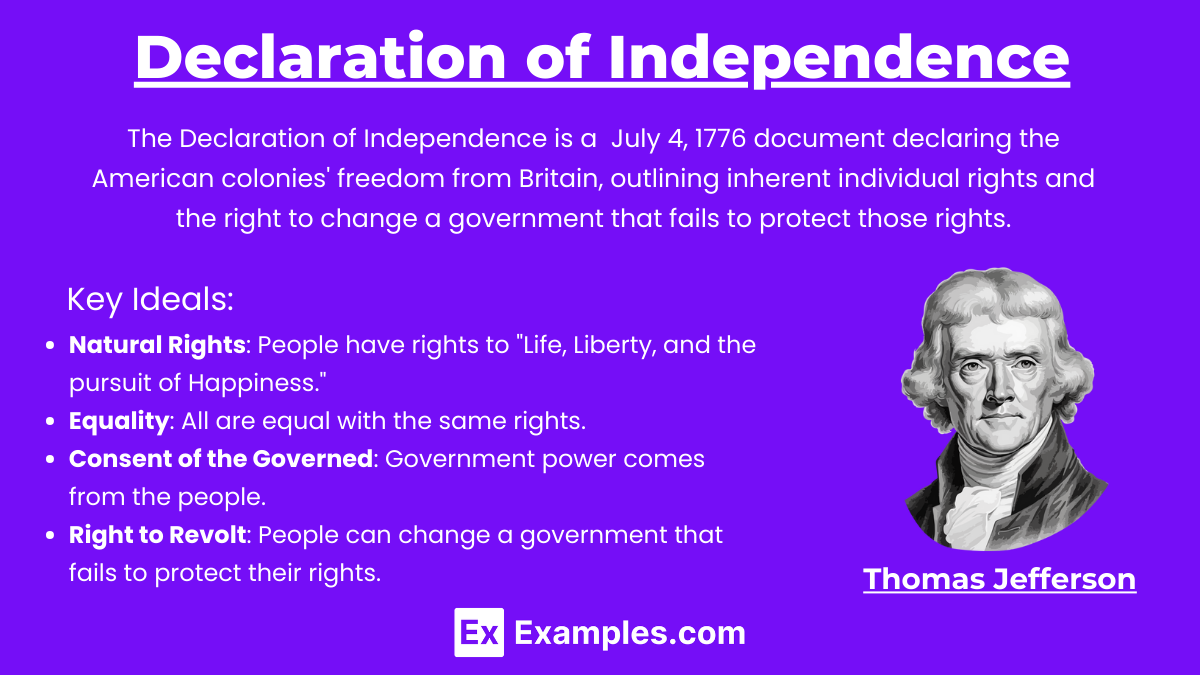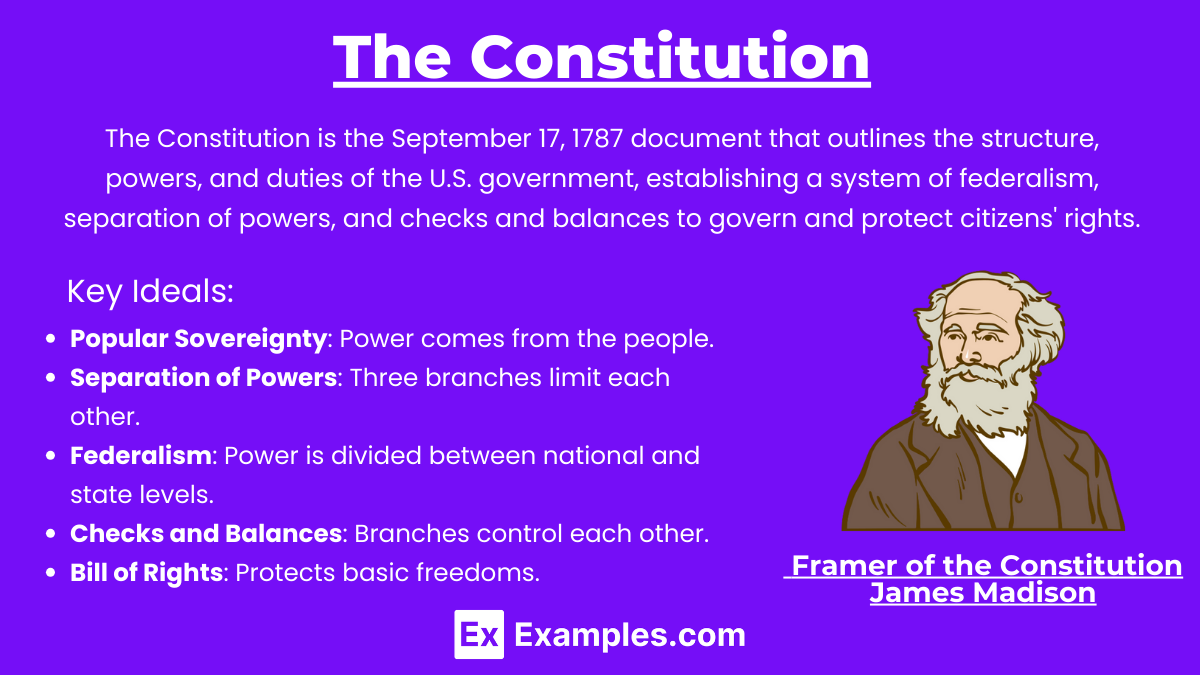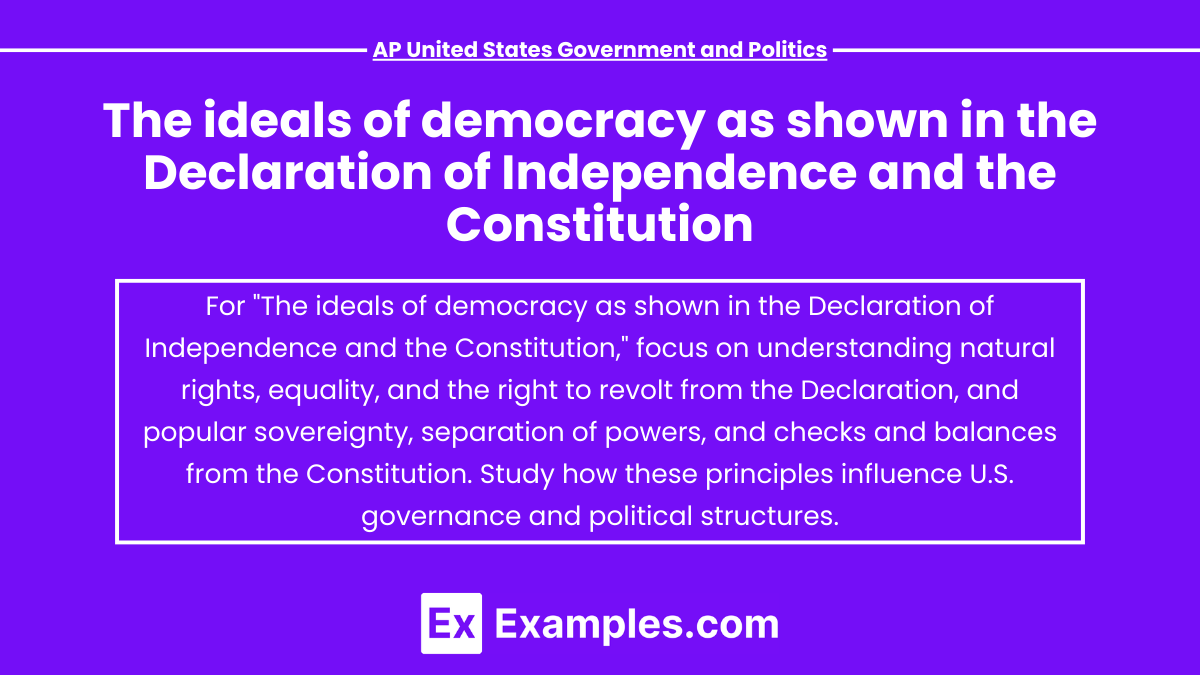The Declaration of Independence and the Constitution are cornerstones of American democracy, embodying fundamental ideals that continue to shape the nation. The Declaration emphasizes natural rights, equality, and the right to revolt, establishing a framework for a government accountable to its people. The Constitution builds on these principles with mechanisms like separation of powers, checks and balances, and popular sovereignty, creating a structured and adaptable system of governance. Together, these documents reflect core democratic values essential to understanding U.S. political principles.
Free AP United States Government and Politics Practice Test
Learning Objectives
In studying "The ideals of democracy as shown in the Declaration of Independence and the Constitution" for AP United States Government and Politics, you should aim to understand how these foundational documents articulate core democratic principles. Key objectives include analyzing the Declaration’s emphasis on natural rights and the right to revolt, and how the Constitution enshrines popular sovereignty, separation of powers, and checks and balances. You should also examine how these ideals have shaped American governance and continue to influence political practices and interpretations today.
Understanding the ideals of democracy as presented in the Declaration of Independence and the Constitution is crucial for AP United States Government and Politics. Here’s a detailed overview to help with your preparation:
1. Declaration of Independence

Date: July 4, 1776
Author: Thomas Jefferson (primarily), with contributions from John Adams, Benjamin Franklin, and others
Purpose: To declare the American colonies' independence from Britain and outline the principles of self-governance.
Key Ideals:
Natural Rights:
The Declaration asserts that all men are endowed with certain unalienable rights, including "Life, Liberty, and the pursuit of Happiness." This reflects the Enlightenment idea that individuals have inherent rights that governments should protect.Equality:
The Declaration states that "all men are created equal," emphasizing the belief that everyone has the same intrinsic value and should have equal rights under the law.Consent of the Governed:
It claims that governments derive their "just powers from the consent of the governed," meaning that legitimate government authority comes from the approval of the people it governs. This principle supports democratic legitimacy.Right to Revolt:
The Declaration argues that people have the right to "alter or to abolish" a government that becomes destructive of these ends (i.e., fails to protect natural rights) and institute a new government. This idea supports the notion that governments must be responsive to the will of the people.
2. The Constitution

Date: September 17, 1787
Authors: James Madison, Alexander Hamilton, and others (Framers of the Constitution)
Purpose: To create a new framework for government that would replace the Articles of Confederation and provide a more effective structure for governance.
Key Ideals:
Popular Sovereignty:
The Constitution is based on the principle that the power of the government comes from the people. This is reflected in the Preamble, which begins with "We the People," signifying that the authority of the government is derived from the consent of the governed.Separation of Powers:
To prevent any one branch of government from becoming too powerful, the Constitution divides government into three branches: Legislative (Congress), Executive (President), and Judicial (Supreme Court). Each branch has distinct powers and responsibilities, and they can check and balance each other.Federalism:
The Constitution establishes a federal system of government where power is divided between national and state governments. This allows for a balance of power and ensures that both levels of government can address different aspects of governance.Checks and Balances:
Each branch of government has the ability to check the powers of the others. For example, the President can veto legislation, Congress can override vetoes, and the Supreme Court can declare laws unconstitutional. This system ensures that no single branch becomes too dominant.Bill of Rights:
The first ten amendments to the Constitution, known as the Bill of Rights, guarantee fundamental rights and freedoms, such as freedom of speech, religion, and the press. These amendments reflect democratic ideals by protecting individual liberties and limiting government power.Representative Democracy:
The Constitution establishes a system of representative democracy where elected officials make decisions on behalf of the people. This is evident in the structure of Congress, where representatives are elected to represent the interests of their constituents.Amendment Process:
The Constitution provides a method for making changes through amendments. This flexibility allows the document to adapt over time while still maintaining its core principles. The process requires significant support to amend the Constitution, ensuring that changes reflect broad consensus.
Examples
Example 1 : Natural Rights (Declaration of Independence)
The Declaration of Independence asserts that all individuals are endowed with unalienable rights such as "Life, Liberty, and the pursuit of Happiness." This idea reflects the Enlightenment belief that certain rights are inherent to all people and should not be violated by governments. This principle has been foundational in shaping American democratic values and protecting individual freedoms.
Example 2 : Equality Before the Law (Declaration of Independence)
The Declaration proclaims that "all men are created equal," emphasizing that everyone has the same intrinsic worth and should be treated equally under the law. This ideal has been a driving force behind various movements for civil rights and social justice in the United States, seeking to ensure that all citizens enjoy equal protection and opportunities.
Example 3 : Popular Sovereignty (Constitution)
The Constitution begins with the phrase "We the People," signifying that the authority of the government comes from the consent of the governed. This principle of popular sovereignty ensures that the government is accountable to the people and operates based on their will, reinforcing the democratic ideal that political power should derive from the electorate.
Example 4 : Separation of Powers (Constitution)
The Constitution establishes three distinct branches of government—Legislative, Executive, and Judicial—each with its own powers and responsibilities. This separation is designed to prevent any single branch from becoming too powerful and to ensure a system of checks and balances. By dividing authority among different branches, the Constitution upholds the democratic principle of limiting government power and safeguarding individual freedoms.
Example 5 : Right to Amend the Constitution (Constitution)
The Constitution provides a formal process for amendments, allowing for changes to be made as society evolves. This process requires broad consensus and ensures that amendments reflect the will of a significant portion of the population. The ability to amend the Constitution exemplifies the democratic ideal of adaptability and responsiveness to the needs and values of the people.
These examples illustrate how the Declaration of Independence and the Constitution enshrine core democratic principles, shaping the governance and protection of rights in the United States.
Multiple Choice Questions
Question 1
Which of the following principles is explicitly stated in the Declaration of Independence?
A) Separation of Powers
B) Federalism
C) Right to Revolt
D) Representative Democracy
Answer: C) Right to Revolt
Explanation: The Declaration of Independence explicitly states that people have the right to "alter or to abolish" a government that becomes destructive of their unalienable rights and to establish a new government. This principle supports the idea that if a government fails to protect the rights of its citizens, they have the right to revolt and establish a new system. While other principles like Separation of Powers and Federalism are key to the Constitution, the right to revolt is a core idea expressed in the Declaration.
Question 2
How does the Constitution address the balance of power among the branches of government?
A) By establishing a unicameral legislature
B) By creating a system of checks and balances
C) By granting all legislative power to the President
D) By allowing states to override federal laws
Answer: B) By creating a system of checks and balances
Explanation: The Constitution establishes a system of checks and balances to ensure that no single branch of government (Legislative, Executive, or Judicial) becomes too powerful. Each branch has distinct powers and responsibilities, and they can check and balance each other’s actions. For example, the President can veto legislation, Congress can override vetoes, and the Supreme Court can declare laws unconstitutional. This system is designed to maintain a balance of power and protect democratic governance.
Question 3
What does the phrase "We the People" in the Preamble of the Constitution signify?
A) The power of the President to enact laws
B) The authority of the Supreme Court to review legislation
C) The principle of popular sovereignty
D) The division of powers between federal and state governments
Answer: C) The principle of popular sovereignty
Explanation: The phrase "We the People" in the Preamble signifies the principle of popular sovereignty, which means that the authority of the government derives from the consent of the governed. This principle reflects the idea that the government is accountable to the people and operates based on their will. It underscores the democratic ideal that political power should originate from the citizens and that they have the ultimate authority in a democratic system.


